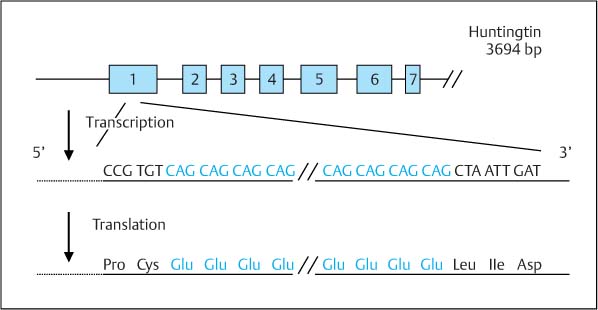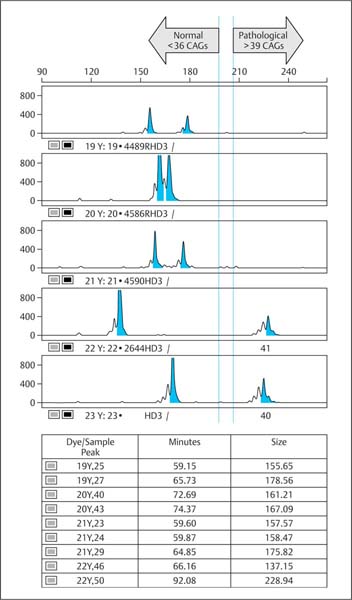Fig. 8.1 By linkage analysis, a gene site on a chromosome having a total length of about 100 million base pairs (A) can be narrowed to a section of a few million base pairs (B). This section contains several genes (blue rectangles). The gene in question (C) can be identified and sequenced using molecular genetic methods. Sections of the gene carrying the information for the corresponding protein (exon sequences) alternate with sections that will be spliced out prior to the final protein synthesis (intron sequences).
Monogenic inheritance. When changes in a single gene lead to disease, this is known as monogenic inheritance. The disease may be due to loss of the normal function of the encoded gene product (“loss-of-function mutation”), or it may develop because the altered gene product has gained a new, harmful function that is independent of the original function (“gain-of-function mutation”).
Polymorphism. When mutations take place outside the coding sequence, they often have no effect on gene function. These harmless variations in the base sequence are common (about 1 in every 1000 bases in the human genome) and are referred to as polymorphisms.
Fig. 8.2 Structure of the CAG trinucleotide repeat sequence in exon 1 of the huntingtin gene. The base triplet CAG is translated into the amino acid glutamine. The CAG repeat thus codes for a polyglutamine domain within the protein.
Molecular Diagnosis
Allelic and Genetic Heterogeneity
The possibilities of molecular diagnostic testing of genetic neurological disorders are very much determined by the genetic complexity of the disease in question. Some diseases, such as Huntington’s disease (HD, formerly known as Huntington’s chorea), are practically always caused by a single genetic change that is relatively easy to identify—in this case, the expansion of a repetitive trinucleotide sequence in the HD gene (or huntingtin gene, see below). Often, however, a disease is caused by different mutations at quite different sites within a gene (“allelic heterogeneity”). Depending on the size of the gene, this may make molecular diagnostic testing technically much more difficult to carry out. In other cases again, mutations in several different genes can lead to clinically identical or very similar diseases (“genetic heterogeneity”). This, too, can complicate molecular diagnostic testing.
Objective and Prerequisites
Objective. The objective of molecular diagnostic testing is to help individual patients or individual families.
Prerequisites. Prerequisites for carrying out molecular diagnostic testing are (Statement of the Practice Committee, 1996):
• Provision of comprehensive information to the patient or other person seeking advice.
• Voluntary and informed consent of the same.
• Absolute confidentiality of the results.
Genetic Counseling
Genetic counseling is an essential part of the diagnostic procedure for genetic diseases. Before any diagnostic procedures are carried out, the patient is informed not only about the nature and course of the disease, but also about potential consequences for his or her family with reference to the most important genetic features of the disease, such as mode of inheritance and penetrance. This patient information process will increasingly frequently have to be provided at least in part by the patient’s physician. Nevertheless, genetic counseling at a qualified department of human genetics should be offered to every patient seeking molecular diagnostic testing of a hereditary disease. The patient may be under a moral duty to share the genetic knowledge with other family members. The counseling physician, however, should not actively inform family members on his or her own initiative.
Seeking diagnosis and genetic counseling is entirely voluntary.
In many cases, identification of the molecular causes of a disease allows a presymptomatic diagnosis to be made, i. e., identification of a genetic predisposition in a clinically healthy person. The reasons for requesting a presymptomatic diagnosis must be thoroughly reviewed in each case. This kind of diagnosis should therefore only be carried out within a framework of competent genetic counseling at a qualified department of human genetics.
Methods
Direct detection of mutations. These days, molecular diagnostic tests are usually based on direct detection of a mutation (“direct DNA diagnosis”). This is easiest when a change in a particular base sequence leads to a particular corresponding disease, as is the case, for example, with trinucleotide expansions (Figs. 8.2 and 8.3). Also relatively easy to detect are large duplications or deletions, like those found in many cases of Charcot-Marie-Tooth disease or tomaculous neuropathy. The detection of point mutations, by contrast, is very time-consuming and costly when the gene is large and the mutations are not clustered in specific regions.
Source of the DNA. The starting point of molecular diagnostic testing is always genomic DNA. Since every cell of the body contains the entire genetic information, the source of the DNA is irrelevant. DNA is usually isolated from the most accessible cells, i. e., leukocytes. Exceptions to this rule are diseases caused by mutations in mitochondrial DNA. Mito-chondria possess their own small genome consisting of a circular molecule 16 569 base pairs in length. Since the distribution of mitochondria varies from tissue to tissue, it can happen that a mutation is not detected in every cell type of the body.
Fig. 8.3
Stay updated, free articles. Join our Telegram channel

Full access? Get Clinical Tree









